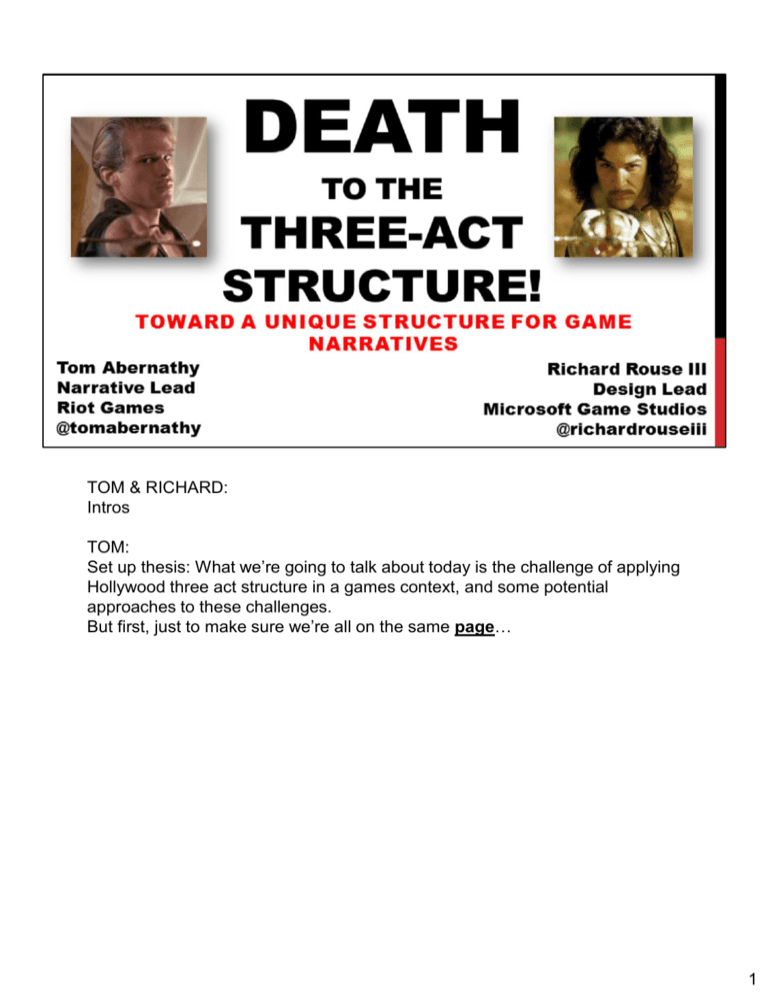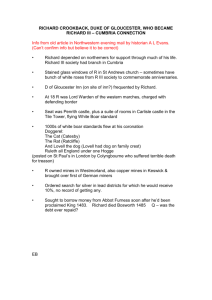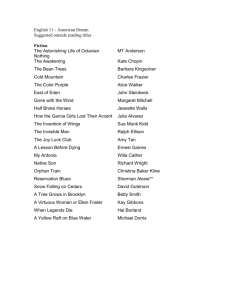Death to the Three
advertisement

TOM & RICHARD: Intros TOM: Set up thesis: What we’re going to talk about today is the challenge of applying Hollywood three act structure in a games context, and some potential approaches to these challenges. But first, just to make sure we’re all on the same page… 1 TOM: William Goldman. Legendary writer of film and fiction. Won the academy award for Butch Cassidy and the Sundance Kid and also wrote the novel and movie version of The Princess Bride, the very images you see on our title page. Famous quote: “Screenplays ARE structure.” A truism that causes pain to pretty much anyone who tries to tell stories well. ‘Cause structure is HARD. But thousands of years of verbal, written, performed and filmed storytelling seem to demonstrate that solid dramatic structure makes a story more satisfying. Which means you’re generally better off thinking about it before you start spewing out words. Now, you’ve probably seen some graphical representations of structure before… 2 TOM: If you’re like me, you may have seen this one in a book of short stories in middle school – Tell-Tale Heart, An Occurrence at Owl Creek Bridge, that sort of thing. Or maybe yours used the word “exposition” for the first part. 3 Or maybe it said “Setting and characters.” (I always did love the word “denouement” best for the end part, though.) 4 Maybe it used the word “Complication” instead. 5 Maybe you’ve even read about something called Freytag’s Triangle… 6 TOM: … an analysis by a 19th century German novelist and playwright named Gustav Freytag. It looks pretty similar in some ways, but it embellishes on the verbiage a bit. The specifics here aren’t important; what matters is that the idea of an ideal story structure has been around for a very long time. In fact, what Freytag was analyzing was something much older, something you may have heard of even if you don’t totally know what it is – something called Three-Act Structure… 7 TOM: Three-Act Structure goes back at least as far as 300 BC and Aristotle (Greek dude). In the Poetics, he asserted that the ideal story had three parts: Protasis, Epitasis, and Catastrophe. Which is basically just a classy Greek way of saying BEGINNING, MIDDLE, and END. At least since Aristotle, people have analyzed story in every medium (theater, fiction, film, etc.) to try to figure out its optimal structure, or, failing that, at least the optimal structure for a given medium. 8 TOM: And when the Hollywood trailblazers of yore asked that question, they came up with something revolutionary. (PAUSE) Okay, that’s a little reductive. Film Crit Hulk puts it like this: with Set Up, Confrontation, and Resolution as the three acts, punctuated by what in Hollywood are called “plot points”: events that alter the course of the story. Syd Field, the original screenwriting guru, embellished the paradigm a bit, adding terms like “Inciting Incident” (the event that sets in motion the central problem or conflict of the story) and “Pinch” (events at the quarter- and threequarter marks of Act II that rachet up the stakes in some way). (By the way, notice that, in Hollywood 3AS, Act II is actually twice as long as Acts I and III. Almost as if it’s more of a FOUR-act structure. Kinda weird. And probably a testament to the influence of Aristotle. But relevant, as we shall see.) Other people have done their own analyses, but the basic shape of the triangle, the rising and falling action, is pretty much always the same. Note that each of these treats PLOT as the driving consideration -- which makes sense, since they’re all analyzing structure. For our purposes, though, Richard and I are gonna treat PLOT as something distinct from STORY or NARRATIVE. When we use those words, we don’t mean PLOT per se – we mean something like FICTIONAL CONTEXT. That may seem like an esoteric distinction, but it’s gonna be useful in a minute. 9 Now: let’s apply this paradigm to a movie we all know and love… 9 TOM: Just kidding – everybody uses Star Wars. Let’s use something else. (Click) TOY STORY! Everybody loves Toy Story! So let’s use that instead. (Click) Let’s use the Syd Field diagram as our map. ACT I: Woody is the leader of the toys in Andy’s Room. Inciting Incident: Andy gets a new toy at his birthday party: Buzz Lightyear! All the toys are dazzled. Woody gets jealous. That’s Plot Point 1, and it propels us into Act II. ACT II Woody tries to get rid of Buzz, which pisses off the other toys. Mom takes the kids to Pizza Planet; she stops for gas, and then drives away while Woody and Buzz are arguing. Woody and Buzz are now alone out in the wider world, separated from Andy and the other toys. Stakes racheted! That’s Pinch 1. They make it to Pizza Planet, and end up getting pulled out of the Claw machine by Syd, who takes them home to “play.” Midpoint (and a low point). Woody and Buzz realize they are in deep trouble: the toys in Syd’s room are scary as hell; Syd tortures Woody; Buzz sees a TV commericial advertising Buzz Lightyear dolls; doesn’t want to believe it; tries to fly; fails and breaks his arm off in the process. Stakes racheted! That’s Pinch 2. 10 Existential crises for both Woody – ‘cause he’s old – and Buzz – ‘cause he’s not a Space Ranger. Hey, they have something in common! And they reconcile. YAY! But Syd decides to strap first Buzz, and then Woody instead, to a bottle rocket. BOO! Oh, and Andy’s family is moving today, and the moving van arrives. That is what we call a ticking clock: if Woody and Buzz can’t escape Syd before Andy’s family leaves for their new house, they’ll lose their kid forever. This is the low point of the movie. Plot Point 2, propelling us into Act III. Act III Escape from Syd’s house. Woody and Buzz and Syd’s toys “come alive” and freak the hell out of Syd! YAY! But the moving truck and Mom’s car leave for the new house without them! BOO! They chase Andy’s family using RC. Realizing he still has the bottle rocket strapped to his back, Woody lights the rocket; he and Buzz fly into the sky – or at least fall with style – and land in Mom’s car, next to Andy. All’s well that ends well… except for the puppy. But that’s another movie. So: Hollywood 3AS maps pretty well to Toy Story. But don’t get the wrong idea; not all movies do, nor do they have to try. Contrary to the way some people talk about it, Hollywood 3AS is not a formula to be slavishly adhered to in every movie. Like Aristotle’s Poetics, it’s really just an analysis of the sort of structure that has often seemed to work pretty well in Hollywood commercial film storytelling. The question for us is: Does it also work pretty well in games? Richard: And I think the three-act structure can work decently for games in some cases, for example… 10 Richard Talks Let’s take a look at a game that does the three-act structure as well as it’s ever been done in games… Uncharted 2 is a great story and maps pretty solidly to the three-act structure. Above I’ve mapped it to the same three act structure chart Tom used for Toy Story, but now it’s stretched out quite a bit, making Act 2 longer. This can be a little problematic in terms of pacing, because there aren’t strong character complications/developments in the plot for the middle 10 hours. The team at Naughty Dog did a lot of smart things to make that three act structure work in a game. For example, instead of a slow-paced start in “the normal world” the game starts in media res (in the middle of the story) with the train crash, starting the game with a bang of action before flashing back to the actual, chronological plot start, which (as is traditional for a 3-act structure) is slower. If there’s any place where it doesn’t work, it’s toward the end of Act 2. It looks like they very much wanted to have a traditional “end of Act 2 low point” from classic Hollywood structure. Nate has a “Disaster and Crisis” that leads to his darkest moment of uncertainty – he doesn’t want to go on. This is problematic 11 because no player wants to stop here, putting them emotionally opposite from their own player character. But of course, no one would dispute that the storytelling in this game is beloved, and rightly so. The plot works well overall, but most importantly the characters are all really well written and the tension in the Nate and Chloe and Elena love triangle keeps us engaged. 11 TOM: So we see 3 act structure can work in games, but maybe there’s other structures that would work even better… Starting with Hill Street Blues and Oz and really getting amped up with The Sopranos, there’s been a resurgence over the last fifteen years or so of longform serialized storytelling on TV, especially on pay networks and some of the basic cable networks. This could be relevant. Show runners have to break story for structure on every level of magnification: scenes, acts, episodes, half-season or full-season arcs (like Breaking Bad or The Wire); multi-season arcs (Game of Thrones), or, if they’re really working at it, whole series arcs (Mad Men). This ability to design story structure at various levels of magnification may scale more effectively for the purposes of some games. One property that’s gotten a lot of attention and succeeded in multiple media – as a graphic novel, a TV show, AND a game, is The Walking Dead. 12 Richard Talks • The Walking Dead is arguably the most successful episodically game we’ve seen to date, with episodes released once every two months. • As a result, the team at Telltale made sure each episode has its own story and feels satisfying by itself as it has a beginning/middle/end. • Characters are introduced in each episode who then have their stories resolved by the end of that episode, never to be seen again. • With a season-arc story of Clementine’s search for he parents – we spend all the episodes with Lee and Clem, and their serial story builds from episode to episode – until the last episode focuses mostly on Lee and Clem. 13 Richard But an even more interesting example comes in The Last of Us, which is very much a serialized story despite not being sold as one big chunk. The game’s creative director Neill Druckman has even called it out as a very serialized structure in interviews. And of course it’s a fantastically well written story (as its many well-earned awards will attest.) Characters come into the story only for a short while, make their own choices, and have their own individual stories cleanly revolved, while only Joel and Ellie stay constant, carrying us through the longer story. 14 Richard • Let’s look at this chart where I’ve added a second dimension to represent rising dramatic tension. • The game is made up of approximately 9 different sub stories that each resolve in their own way • If we look at it structurally, we see that each of these sub-stories has its own rising action and resolution • All the while Ellie and Joel’s story keeps intensifying over the “season” of the whole game • Yet the entire thing builds towards an overall climax – much like the season of a TV series. • You could superimpose three-act structure on this and call the first chapter act 1 and the last one act 3, but I don’t think that’s what it really is. 15 Richard * But we’re not the first people to bring up this idea of filling your game with shorter, meaningful story chunks * At GDC Next last fall Jeremy Bernstein did a talk about Sequence Structure – something that has been discussed in Hollywood but which Mr. Bernstein pointed out was perfect for games. 16 Richard Talks • Instead of being stuck with a really long act 2, with sequence structure you have meaningful narrative events happen as many times as you need • When used in film, Bernstein talks about these sequences have a15 minute rhythm. • And his point was this can work for games too – often aligning these with the “levels” and hence gameplay patterns of your game • Bernstein did this on Dead Space 2. • Though very few games manage to have these sequences be 15 minutes long – even The Last of Us had 60 to 90 minute sequences, instead of 15. • It’s a good talk, go watch it on the vault. 17 Richard Talks • But at the end of Bernstein’s talk, someone asked a question: “Yeah, but how does this apply to open world games?” • In these, you don’t know what order the player is doing the missions in, so how can you apply any sort of rising action to the whole thing? 18 Richard Talks • And he basically says “not very well.” He doesn’t feel narrative structure works in these games. • Because how can it? You don’t know what order the player is going to do the missions in, or even they’ll do all of them. 19 Richard Talks • Take Fallout 3. • It does exactly what Bernstein says, except I needed to shrink Act 1 and Act 3 down even farther than in his original diagram. • Fallout 3 has a “main quest” but that’s less than a quarter of the content. • Most is in the little stories you find along the way. The side stuff. • It would appear that in a game like this, authorial control over the structure is greatly diminished, if not lost completely. • And yet!! These type of RPGs are games “story gamers” particularly love. Why is that? 20 TOM: Another interesting piece of data to bring to the table comes from MS User Research. MS User Researcher Deborah Hendersen (who you may have seen speak earlier today) did a study a couple of years ago that might help to answer that question. She discovered that players really hardly remember the specific plots of the games they play. When asked “tell me the plot of your favorite game” players were unable to talk at length or with much accuracy. However, they were *very* able to recall the plots of movies and TV shows they loved. The chart above shows how many words they used in their descriptions – an objective measure that could be used to reflect their degree of recall. 21 RICHARD: * Interestingly though, players were able to remember game *characters* really well. • And the gameplay itself, and their role in it - any missions that were tightly aligned with the gameplay. • So why is this? • Some would say that it’s because we haven’t written a good story yet. Though I agree a lot of game stories aren’t great, I say some of them are we’ve had really smart people working on this problem for 30 years… so I don’t think our plot memorability issue is for lack of trying. • I think it’s more fundamental • For one, when playing a game, players are engaged first and foremost with the game – they have to be or they can’t finish. • Second of all, often in games narrative is more spaced out them gameplay – by a lot, making it very hard to track if it isn’t directly tied to the gameplay. • Remember, unlike the 15 minutes Jeremy suggested works in film for sequence length, games are often much longer between plot developments. • And the narrative may be even more spaced out of players are challenged by a section – you don’t know how long it will take them to get through. • I think by having players engage most of their brains on the gameplay, then throwing in story around it, players will pick up on some things but not 22 others. • So simple plots that align closely to the player’s objectives, perhaps… • Anything more than that you’re probably screwed. ---(Potential detour – I recently attended the McKee Story conference, and when I asked him what he thought about games, he said the thing all 70 year old writers will say “They’re not art!” But seriously, he also said something smart – when people come to these non-passive narrative experiences, they’re looking for something fundamentally different than what they get in books/movies/plays. They’re looking to interact first and foremost, and to appreciate a precisely crafted story as he teaches, you need to be paying attention only to that, not also distracted by gameplay.) 22 TOM: And you know what’s another nail in the coffin of game structure being meaningful? Statistically, most players don’t finish games. Even games that are known mostly for their stories, people don’t finish. (Yes, that’s Portal, the “short” game praised as game-of-the-year and a narrative triumph – less than 50% of people finished *that*) So how much does your third-act payoff matter if the majority of players never even see it? You may want to ask yourself: will people still like and get something out of my story if they never see the ending? 23 RICHARD: And indeed, some of those games that are legendary for their story, don’t even follow Hollywood screenwriting structure at all. Take for instance Portal… Portal’s Story is about the player’s relationship to/understanding of Glados – 24 RICHARD: I see the story structure of Portal more like this. We follow as our perception Glados goes from friendly test-giver to possibly broken AI to revealing herself to be homicidal – our relationship with her follows a straight arc, as does the game’s difficulty/complexity – There aren’t twists or complications per se that don’t fall directly out of her character Story wise, more of a straight character study than a plot with ups and downs. 25 RICHARD: Or BioShock 2, a story I liked a lot – a mostly linear “fat pipe” game that defies normal structural analysis. The story explores your relationship with a daughter-like figure, and how the choices you make as a player end up shaping her life. I asked Jordan Thomas, the game’s writer, if he was thinking about structure when he was writing it… 26 RICHARD: … and he being Jordan Thomas gave a mind-melting answer. He said He thoughts about three act structure, but deliberately didn’t let it play out conventionally because of the medium. If you’ve played the game, you’ll understand this quote, maybe. I’ll leave that for you to cogitate on later. But we see that he had to move away from structure in order to do what he wanted with this very distinct game story. 27 RICHARD: And what of the recent crop of indie games, praised by critics and fans for their bold new takes on game Narrative… For instance, in Papers Please you don’t even really know the story is happening until very late in the game – it’s so entwined in the game mechanics. Not unlike a “cinema verite” experience - slice-of-life without clear start or end – choice points are inserted into the progression of events organically, and intertwined with game mechanics in a way you may miss them entirely – where you may not realize that the “tension is rising” until it’s already too late – and there’s 20 (?) different endings! And Stanley Parable is… the Stanley Parable. Linear-Structured it’s not. So these narrative indie games don’t fit any sort of conventional story structure, but make you live out gripping stories in ways only a game can. It seems like we have as many examples that don’t use structure in any traditional sense as that do… and the ones people really love often don’t seem to worry about it. 28 RICHARD: When we started working on this talk we thought that we would propose a new way of thinking about structure for games Perhaps suggest a structure that could work for all games. 29 RICHARD: But guess what? We reached a different conclusion. 30 RICHARD: I’m going to be bold and say that William Goldman doesn’t work here. Game stories are NOT about structure. Structure may work for some games, but I think the evidence we’ve presented here today suggests that it is no where near the pre-requisite to narrative success that it is in linear media. So I don’t think there is one “globally applicable game structure”, And if narrative structure is the first thing you’re worrying about in your story, you’re doing your narrative wrong. 31 TOM: So, if it’s non-structural, what conclusions can we draw for how to approach game narrative? First of all: In games, plot is highly overrated. I have often told teams this, and they often didn’t believe me. But the user research data accumulated by Deborah Henderson and MS UR proves it out. Players don’t remember plot. What do they remember? Character, and their own user experience. SO: Focus on character – but make sure the character’s motivations are aligned with the motivations you’re leading the player to experience as well. A seamless marriage of those things will satisfy them, delight them, and stick with them for a lot longer than your plot ever will. In the same vein, make sure your story is aligned with the structural needs of your game’s design, not only in the user experience, but also in aspects like the learn-practice-master loop and level and mission design. To the extent you do build out a plot, pay close attention to the needs of those elements and construct the dramatic rhythms of the experience to support them. 32 RICHARD: • I challenge everyone is room to think about what you remember about games with stories you love. • I’ll bet you it’s either gameplay you participated in (perhaps a specific moment) or interesting characters. • Even for the games that had strong structures, it’s probably NOT the plot that you remembered. 33 RICHARD: • And chances are when you think of some of your favorite stories many of them, like the ones we talked about today, have nothing to do with conventional narrative structure. • It’s my sincere hope that we’ve presented enough evidence today to the hardcore structuralists in the audience will soften their positions and have no choice but to admit that our medium is not one where structure is king. • And for those of you who agrees with us, I hope this talk has given you ammunition, so that the next someone comes into your office waving the latest trendiest screenplay structure book at you as a way to “make your story better”, tell them that you heard some guys at GDC boldly proclaim • “Death to the Three Act Structure!” 34 Thanks. 35







